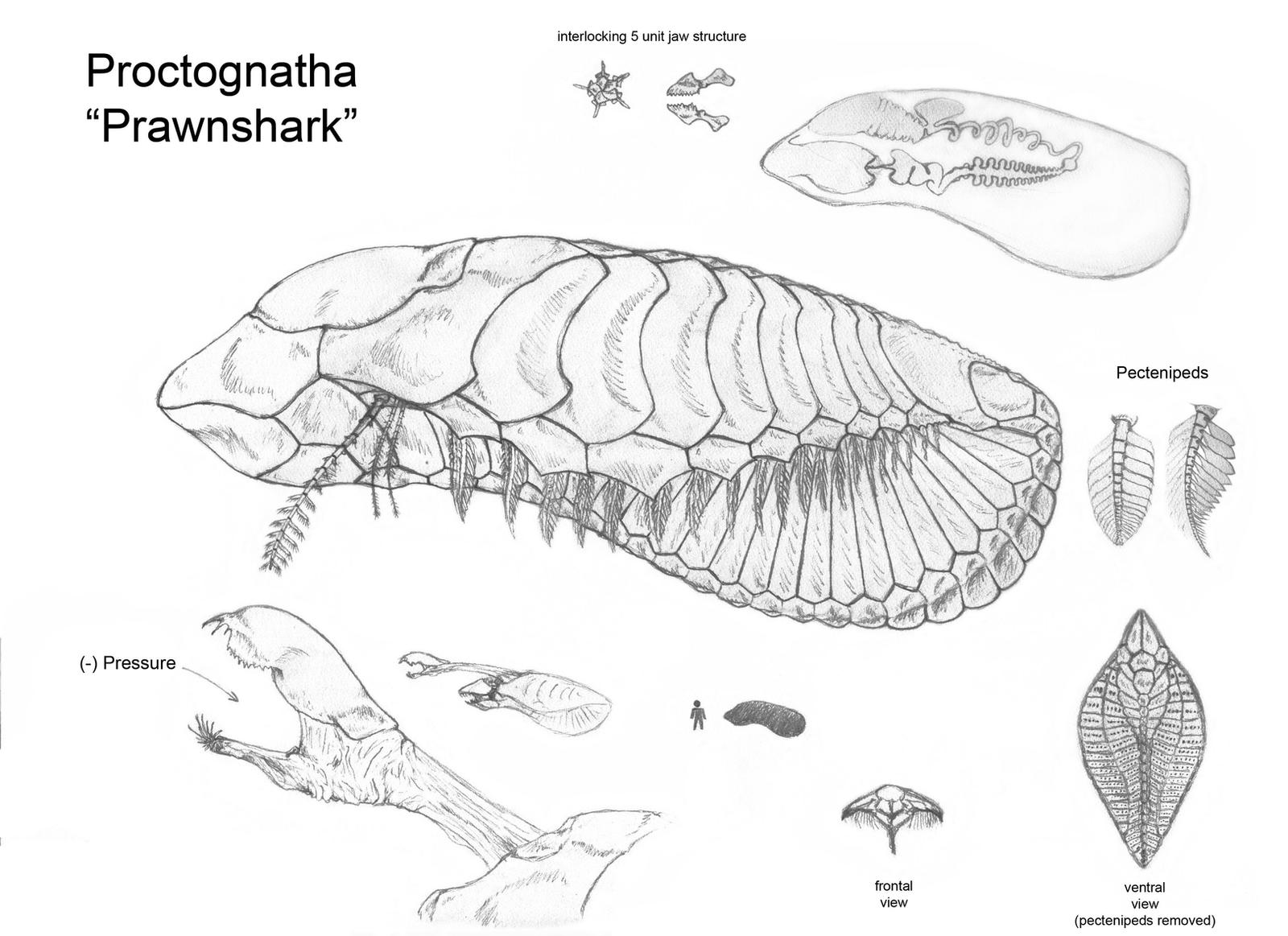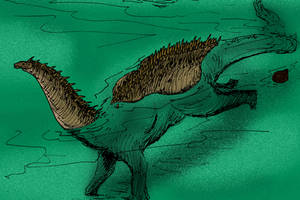ShopDreamUp AI ArtDreamUp
Deviation Actions
Suggested Deviants
Suggested Collections
You Might Like…
Featured in Groups
Description
Yes, just about anything that swims can be labelled a fish.
Pictured is an unnamed species of proctognathan, which are also known as prawnsharks for their shrimp-like appearance, and their raptorial predatory lifestyle.
Proctognathans are in the large clade known as ctenopoda, named for the comb-like rows of appendages on their undersides. Ctenopods are the other dominant group of animals on Erytheia, along with the loricates. The two groups seem to be in a constant competition with one another; for food, space, and dominance. Much of the diversity found in both groups is thought to be the result of this intense competition.
Contrasting with the non-segmented loricates, who descended from a tetraradially symmetrical ancestor, the ctenopods are blatantly segmented (though the presence of a radial, five-piece jaw apparatus in the pharynx suggests an ancient radial symmetry), much like earth's annelids and arthropods. It is unclear if ctenopod segmentation develops the same way as any embryonic segmented animals on earth. From the few juvenile and larval specimens caught, it would seem that new segments are added as the larva matures, and then once the larva has reached a certain stage, tagmatization, or specialized modification of the segments is undergone. Tagmatization is usually as simple as the fusing of segments.
All ctenopods have a looped gut; that is, it makes a U-turn at the base of the colon, and then sweeps back toward the anterior end so the anus terminates near the head. This is similar to the phoronids on earth (see Horseshoe worms). In ctenopods the anus has been highly modified, and in proctognaths has been modified into a set of jaws called the anomaxilla, and is used for raptorial feeding as well as respiration, though proctognaths respire very little through the anomaxilla since their pectenipeds are the primary means of respiration.
The extent to which the anomaxilla can extend depends on the species, with some stretching less than a meter, while in others the external region of the colon is longer than the length of the body and acts as a flexible, versatile neck for sweeping into schools of placoicthoids or other prey. The other four, tooth-lined appendages surrounding the mouth act like palps to transfer the food from the grip of the anomaxilla into the mouth.
The many rows of pectenipeds on the proctognathan underside serve two purposes. Already mentioned is the use for respiration, which is facilitated by a large amount of vascularization. The other use is locomotion, which is conducted in much the same manner as crustaceans like krill or prawns, but with a little more efficiency and control. In all proctognathans, at least the first three pectenipeds are modified into olfactory sense appendages. The number of modified pectenipeds varies among different proctognathan groups.
Along the outside of the porous, calcium carbonate carapace, fine, tiny hairs run in lines, and concentrate in clumps at the anterior end and the hood of the anomaxilla. These hairs sense vibrations and pressure differences in the water and help the proctognath to sense the environment around it. Photosensitive cells on the dorsal surface orient the animals properly in respect to the Erytheian sun. Lack of eyes means that other senses like auditory (sensing changes in water pressure against the body) and olfactory ("smell") are highly sensitive.
Large species such as this one tend to be nocturnal, as their primary senses have an advantage in low-light conditions, when light-dependant creatures are vulnerable.
Pictured is an unnamed species of proctognathan, which are also known as prawnsharks for their shrimp-like appearance, and their raptorial predatory lifestyle.
Proctognathans are in the large clade known as ctenopoda, named for the comb-like rows of appendages on their undersides. Ctenopods are the other dominant group of animals on Erytheia, along with the loricates. The two groups seem to be in a constant competition with one another; for food, space, and dominance. Much of the diversity found in both groups is thought to be the result of this intense competition.
Contrasting with the non-segmented loricates, who descended from a tetraradially symmetrical ancestor, the ctenopods are blatantly segmented (though the presence of a radial, five-piece jaw apparatus in the pharynx suggests an ancient radial symmetry), much like earth's annelids and arthropods. It is unclear if ctenopod segmentation develops the same way as any embryonic segmented animals on earth. From the few juvenile and larval specimens caught, it would seem that new segments are added as the larva matures, and then once the larva has reached a certain stage, tagmatization, or specialized modification of the segments is undergone. Tagmatization is usually as simple as the fusing of segments.
All ctenopods have a looped gut; that is, it makes a U-turn at the base of the colon, and then sweeps back toward the anterior end so the anus terminates near the head. This is similar to the phoronids on earth (see Horseshoe worms). In ctenopods the anus has been highly modified, and in proctognaths has been modified into a set of jaws called the anomaxilla, and is used for raptorial feeding as well as respiration, though proctognaths respire very little through the anomaxilla since their pectenipeds are the primary means of respiration.
The extent to which the anomaxilla can extend depends on the species, with some stretching less than a meter, while in others the external region of the colon is longer than the length of the body and acts as a flexible, versatile neck for sweeping into schools of placoicthoids or other prey. The other four, tooth-lined appendages surrounding the mouth act like palps to transfer the food from the grip of the anomaxilla into the mouth.
The many rows of pectenipeds on the proctognathan underside serve two purposes. Already mentioned is the use for respiration, which is facilitated by a large amount of vascularization. The other use is locomotion, which is conducted in much the same manner as crustaceans like krill or prawns, but with a little more efficiency and control. In all proctognathans, at least the first three pectenipeds are modified into olfactory sense appendages. The number of modified pectenipeds varies among different proctognathan groups.
Along the outside of the porous, calcium carbonate carapace, fine, tiny hairs run in lines, and concentrate in clumps at the anterior end and the hood of the anomaxilla. These hairs sense vibrations and pressure differences in the water and help the proctognath to sense the environment around it. Photosensitive cells on the dorsal surface orient the animals properly in respect to the Erytheian sun. Lack of eyes means that other senses like auditory (sensing changes in water pressure against the body) and olfactory ("smell") are highly sensitive.
Large species such as this one tend to be nocturnal, as their primary senses have an advantage in low-light conditions, when light-dependant creatures are vulnerable.
Image size
3510x2550px 892.86 KB
© 2011 - 2024 Onironus
Comments15
Join the community to add your comment. Already a deviant? Log In
whoa.































